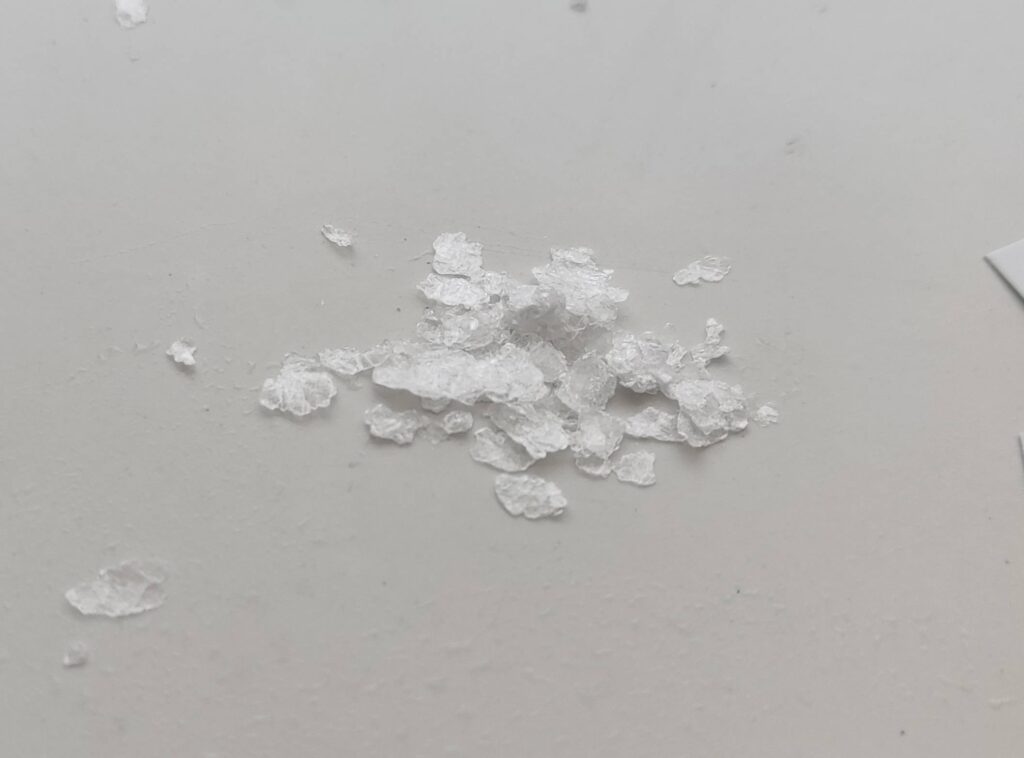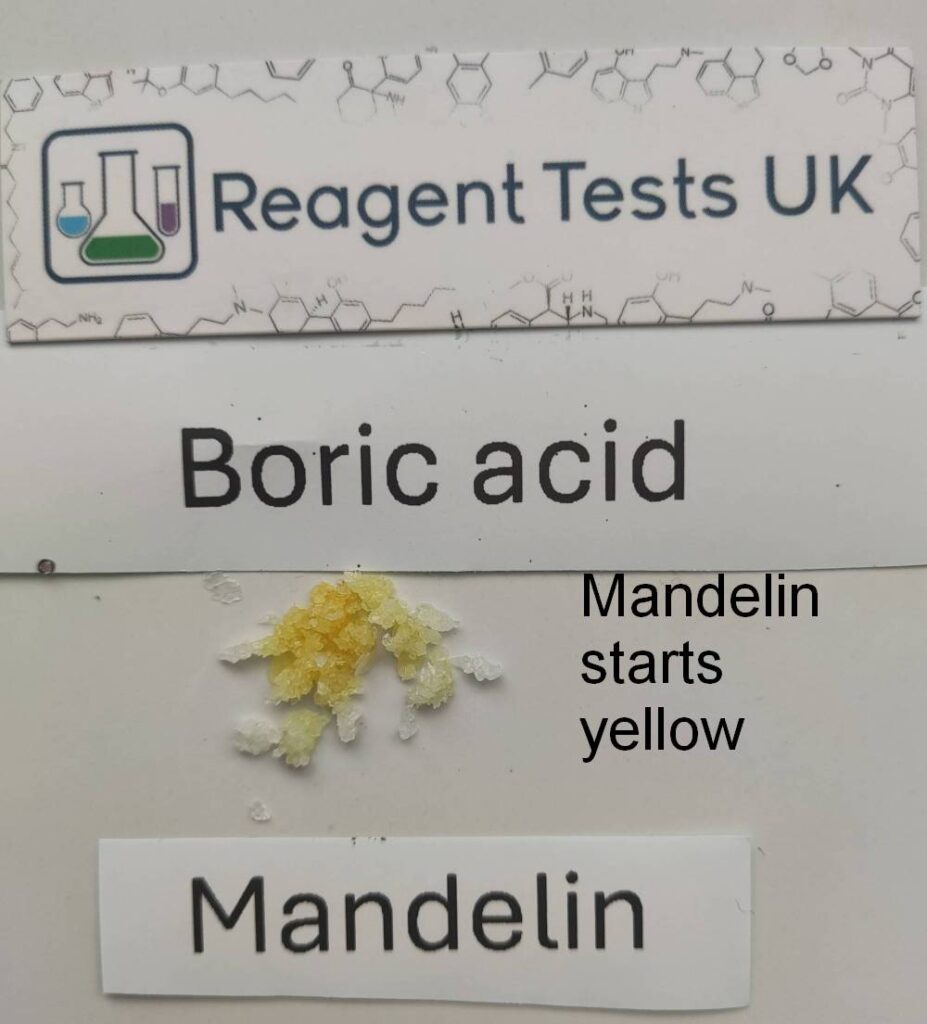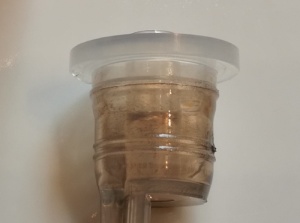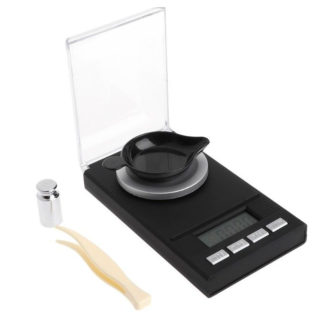The illicit drug trade is fraught with dangerous practices, one of which is the addition of adulterants to bulk up the product and increase profits. One such substance that has been used in cocaine is boric acid. This addition is particularly concerning because it can introduce a host of health risks. But why is boric acid used, and how can it be detected?

The picture shows magic boric acid “fishscale” cut. Pure boric acid flakes are distinguishable from cocaine, but when mixed together in smaller amounts it is impossible to spot them.
Why Boric Acid?
Boric acid is chosen as an adulterant for cocaine primarily because of its physical properties. Cocaine, in its pure form, often has a shiny, pearlescent quality, reminiscent of fish scales. Boric acid, when ground finely, also possesses a similar sheen, making it an attractive option for unscrupulous dealers looking to pass off diluted cocaine as pure. The visual similarity can deceive users and law enforcement, making it a stealthy and effective adulterant.
Boric acid is white, has no smell, and tastes very slightly bitter and sour. This subtleness means it is easily overpowered by anything else in the mixture.
Detecting Boric Acid in Cocaine
Detecting boric acid in cocaine can be challenging but not impossible. One simple method hinges on the solubility differences between the two substances. Cocaine is highly soluble in water, whereas boric acid is not. Here’s how this principle can be applied:
Solubility Test:
- Measure out 1 gram of the sample. You can use our precision laboratory scales for this.
- Attempt to dissolve it in 5 g (5 mL) of water at room temperature. If the substance dissolves easily with agitation within 10 minutes, it indicates there is little or no boric acid. However, if the substance does not dissolve completely, boric acid might be present.
- To further test for boric acid, microwave the liquid in an open container for 10 seconds and agitate the solution.
If there is less than 0.75 g boric acid in your 1g sample then the boric acid will slowly dissolve in 5 mL of hot water. - Allow the solution to cool in a fridge for 30 minutes.
Cocaine will stay dissolved, but boric acid will “precipitate” and make the solution cloudy, then sink to the bottom as a sediment.
Removing Boric Acid from Cocaine
- You can decant the water into another container, leaving the sediment behind. The water can be evaporated on a plate with a fan.
- The residue on the plate will contain any cocaine and water soluble drugs and cuts such as benzocaine, MDPVP, 3‑MMC, and amphetamine. To detect other cutting agents, you will need a home cocaine testing multipack or a lab test.

The picture shows 0.5g boric acid sediment in 10mL of water.
Advanced notes:
- (Caffeine will also precipitate in cold water, but it forms larger clumps of fluffy crystals and struggles to sink.)
- (Cellulose binder from crushed pills and calcium carbonate will never dissolve.)
Chemical Testing
Home reagent tests like the marquis reagent don’t change colour for boric acid, but they do detect a huge range of other molecules. They are designed to detect the presence of other drugs that present a serious risk but also detect other cutting agents.
You can see the different colours that other chemicals go here: Instructions for Using Reagent Tests
Health Risks
It’s important to highlight the health risks associated with the use of boric acid in cocaine. Boric acid is not meant for human consumption and can cause a range of adverse effects, including:
- Nausea and vomiting
- Abdominal pain
- Diarrhea
- Skin irritation
With high doses or regular consumption, boric acid poisoning can lead to more serious health issues such as renal failure, seizures, and even death. This makes the practice of cutting cocaine with boric acid particularly dangerous and underscores the importance of awareness and testing.
If you are regularly consuming diluted cocaine and change to a supplier offering high purity, you could overdose from your normal dosage. Keep in mind that cocaine itself has health risks. Even when it is completely pure, cocaine disrupts the rhythm of the heart, prevents sleep (leading to temporary psychosis) and damages delicate tissues such as in the nose and gums. Use a saline spray after using cocaine to reduce the damage it does in the nose.
Reagent test results for boric acid
Note that the mandelin reagent is naturally yellow. None of the reagents show a change in colour.
| Substance tested | Name of reagent | Colour change after 60-120 seconds |
| Boric acid | Marquis | No colour change |
| Boric acid | Froehde | No colour change |
| Boric acid | Liebermann | No colour change |
| Boric acid | Mandelin | No colour change |
| Boric acid | Mecke | No colour change |























